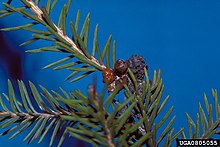Spruce whisker scale insects
| Spruce whisker scale insects | ||||||||||||
|---|---|---|---|---|---|---|---|---|---|---|---|---|
| Systematics | ||||||||||||
|
||||||||||||
| Scientific name | ||||||||||||
| Physokermes | ||||||||||||
| Targioni-Tozzetti , 1868 |
Spruce whiskers ( Physokermes ) are a genus within the suborder of plant lice (Sternorrhyncha). They live on spruce , fir , pine and Douglas fir .
features
The females are 2.5–6 mm long, 2–5 mm wide, unsegmented, spherical or coffee bean-shaped, elongated, shiny, light chestnut brown, occasionally spotted with a little reddish. They usually sit in groups in the spruce axils of the previous year's shoots. Males are significantly smaller than the females and are winged. They sit directly on the needles of the spruce trees.
Way of life
The females become sexually mature in May / June and lay around 3000 red eggs under their shield. In the same month the pale red larvae hatch and attach either to the whorls of the host branches (future females) or to the needles of weak branches (future males). In September they turn brown and migrate to the top whorl to hibernate. In the spring of the following year, they grow into adults.
meaning
In Central Europe, the small and large spruce whisker scale are of particular importance, as they are among the suppliers of fir honey. The large spruce whorl scale ( Physokermes piceae ) particularly attacks forest stands with spruce (Picea), whereas the small spruce whorl scale ( Physokermes hemicryphus ) is also found on silver fir ( Abies alba ). While the latter can be found predominantly on older trees, locations with cold, wet soils or very dry subsoil are preferred, the Great Spruce whorl scale ( Physokermes piceae ) prefers to colonize younger plants, especially in persistently dry weather.
Physokermes rarely appear as pests; damage can only be caused in dry locations and in young crops. The animals suck the sap from all parts above ground, which weakens the plants and the development of the young shoots can suffer. Discoloration occurs due to dried out needles and branches, which can affect the entire plant in the event of an acute attack. Indirect damage can result from the excretions, which produce a characteristic gray-black varnish that later becomes even darker and can reduce photosynthesis.
If they occur more often in areas with a warm and dry climate, beekeepers welcome them as suppliers of honeydew . Sometimes black develops on the honeydew excreted Rußtaupilze which color needles and shoot segments black.
Host plants
Picea excelsa, Picea pungens, Picea argentea, Picea sitichensis, Picea orientalis, Abies alba, Abies pectina, Pseudotsuga menziesii, Pinus sylvestris
Species list
- Physokermes coloradensis
- Physokermes concolor
- Physokermes fasciatus
- Physokermes hemicryphus (Small spruce whorl scale, also called Small Lecanie)
- Physokermes inopinatus
- Physokermes insignicola
- Physokermes jezoensis
- Physokermes piceae (Great Spruce whorl scale, also called Great Lecanie)
- Physokermes shanxiensis
- Physokermes sugonjaevi
- Physokermes taxifoliae
literature
- Wolfgang Schwenke (Ed.) Among others: The forest pests of Europe , Volume 1: Worms , snails , arachnids , millipedes and hemimetabolic insects . Parey, Hamburg and Berlin 1972, ISBN 3-490-11016-1
Web links
- Physokermes at Scale Net ( accessed November 16, 2012)
- On the impact of environmental influences on the population development of the Physokermes species Hermann Pechhacker 1977 (PDF file; 319 kB)
- Small and large spruce whisker scale
Individual evidence
- ↑ a b c d Physokermes piceae (closet) & P. hemicryphus ( Memento from October 11, 2008 in the Internet Archive ) on faunistik.net, accessed on February 27, 2014.
- ↑ On the ecology and economic importance of the Physokermes species (Homopt. Coccoidea) on spruce in southern Germany on onlinelibrary.wiley.com, accessed on February 27, 2014.
- ↑ Physokermes Piceae on doiserbia.nb.rs, accessed February 27, 2014.

